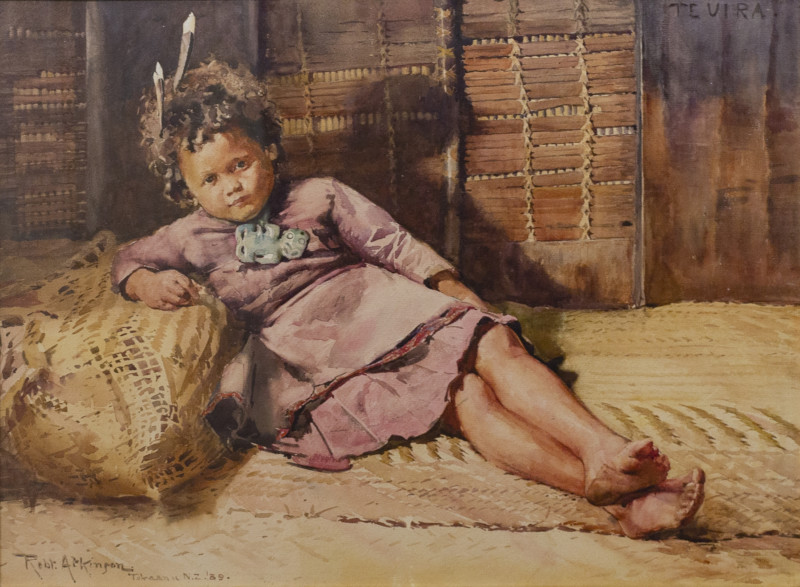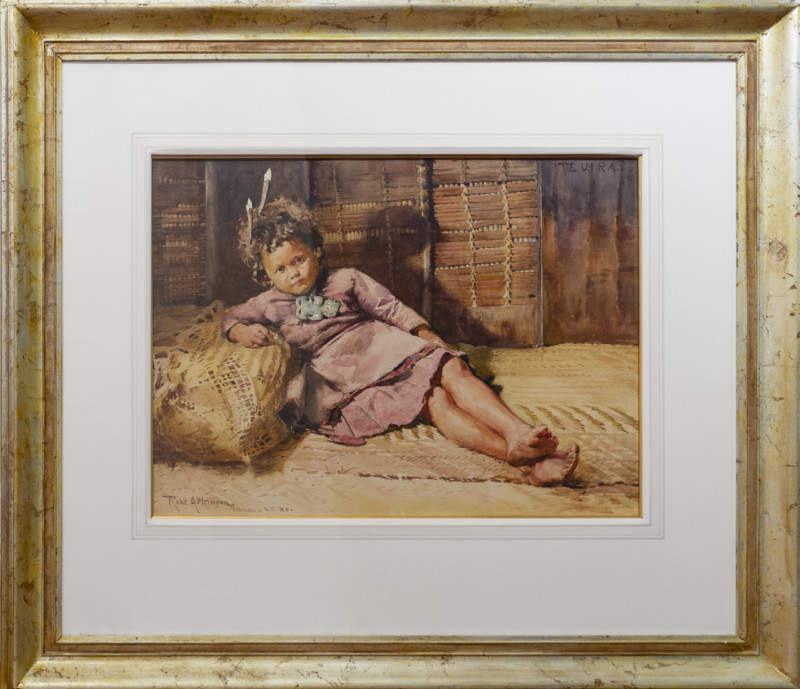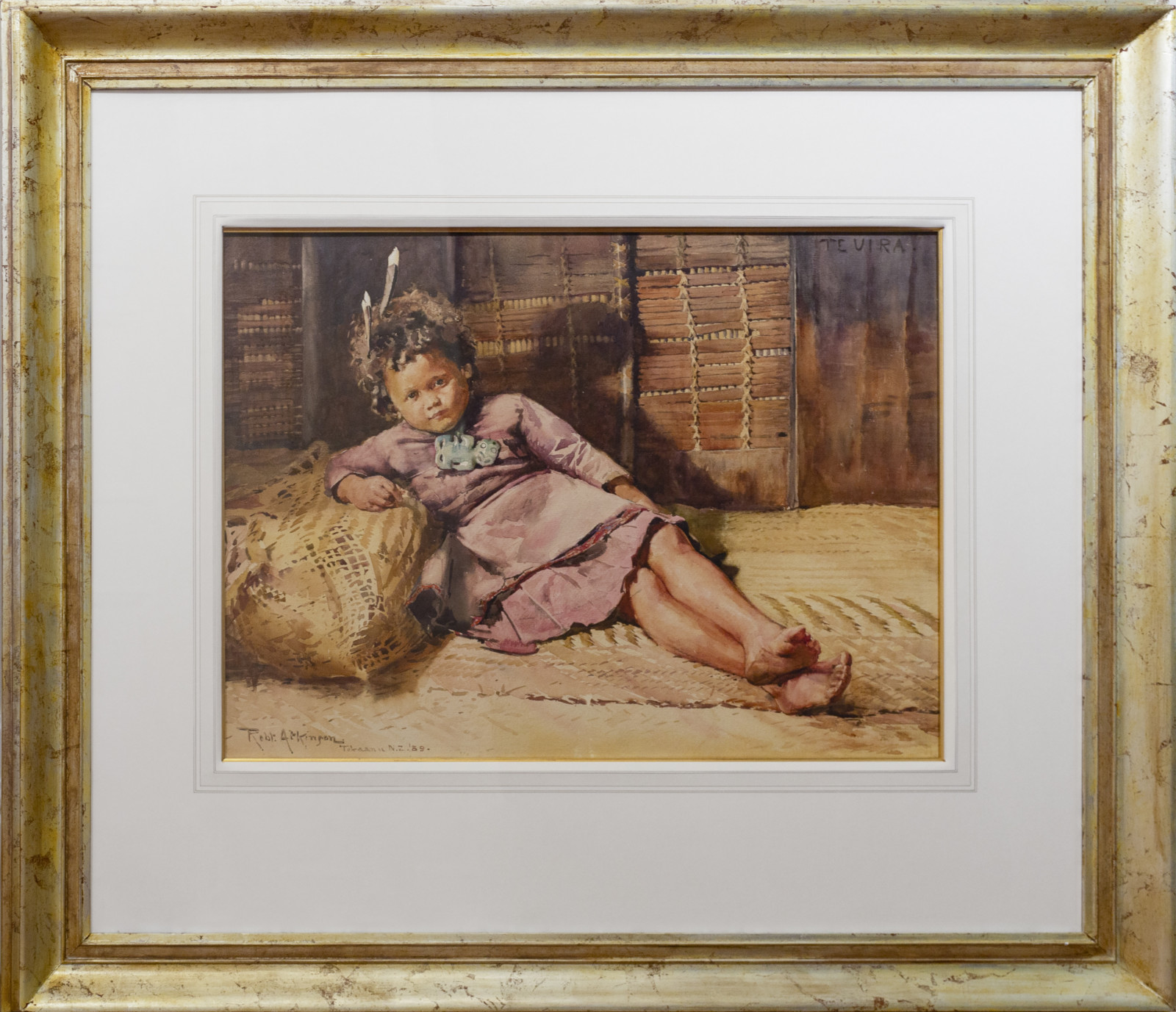ATKINSON, Robert;
Portrait of Te Uira Te Heuheu
1889
Watercolour on paper
525 x 720mm (image); 1015 x 1170mm (frame)


The following two texts were written for Te Huringa/Turning Points and reflect the curatorial approach taken for that exhibition.
Peter Shaw
Te Uira was the daughter of Te Heuheu Tūkino V of Ngāti Tūwharetoa. Her grandfather, Te Heuheu Tūkino IV, also painted by Atkinson, had in 1887 gifted the mountains Tongariro, Ngāuruhoe, and Ruapehu to the nation.
Te Uira’s portrait, painted when she was six, was made at Tokaanu, on the southern shores of Taupō, by an artist who settled in Tāmaki Makaurau in 1884. He operated a studio in Victoria Arcade but in 1890 moved to Sydney, taking this portrait with him. In 1891, he sent it to London, where it was exhibited at the Royal Academy and purchased. In 1986, it appeared in an art auction catalogue and was bought and repatriated.
Te Uira spent a good deal of her childhood in Wellington, where her father was a member of the Legislative Council. She accompanied him at official functions and took part in the apparently lavish entertainments he hosted at the family home called Tongariro, at Lyall Bay. She was a repository of much ancient Māori knowledge, an accomplished musician and an artist. A devoted supporter of the Kīngitanga, Te Uira was for a time married to Taitu, the son of King Mahuta Tāwhiao. This arranged marriage was not a success and Te Uira returned to her own Tūwharetoa people. Despite this, Te Puea Herangi had recognised her unique qualities as one who could bridge Māori and Pākehā cultural worlds and saw to it that she continued to play an important role in political affairs. In opposing conscription during the First World War, Te Uira, a woman of intense conviction, publicly aligned herself with Tainui against her Tūwharetoa people.
Painted in an interior, replete with dilapidated detail, the subject gazes out at the viewer with a curious mixture of charm and determination. Her carefully elegant pose, involving foreshortening of crossed feet at the ankle, has caused the painter some difficulty.
Jo Diamond
What a service Atkinson provides with this depiction of a renowned female ancestor of Tūwharetoa, conveying homage to a rangatira, Te Heuheu Tūkino, and all his whakapapa.
Te Uira’s youthfulness in this painting portends the life she led during an era of dramatic change for many Māori of her day. Nevertheless, there are potent ambiguities represented by taonga Māori in this picture. Most notable are the large tiki pounamu and the huia feathers she wears in her hair and around her neck. Such signatory elements, undeniably an essential part of Māori culture, sit rather ambiguously with Te Uira’s distinctly European dress, with its pleated skirt. Unlike the misshapen kete she leans on or the fraying whāriki on which she sits, matching the worn tukutuku panels behind her, the feathers and pounamu appear timelessly intact. The child has an air of fragility, despite her youthfulness and perhaps because of the surrounding damaged items. These shabby remnants of Māori culture appear to signal a decline in the face of the spread of European influence, something that is symbolised by the child’s pink dress and possibly by her reclining pose, which is quite uncharacteristic of Māori children. Is this an imposed European-based styling or does it indicate something in the subject’s personality?
I delight in the fact that the mature Te Uira Te Heuheu is recorded as leading a full and influential life that retained much mana. Here, the youthful resolve in her face heralds the struggle against the possibility of Māori cultural decline that is ‘voiced’ in the dilapidated cultural vestiges that surround her and which it was her life’s work to overcome.
Inscriptions
TE UIRA [u.r.] ; Robt. Atkinson / Tokaanu N.Z. '89. [l.l.]Exhibition History
Te Huringa/Turning Points: Pākehā Colonisation and Māori Empowerment, Sarjeant Gallery Te Whare o Rehua, Whanganui, 8 April to 16 July 2006 (toured)
Provenance
1992–
Fletcher Trust Collection, purchased from R. H. and J. L. Catley, March 1992
–1992
Unknown


